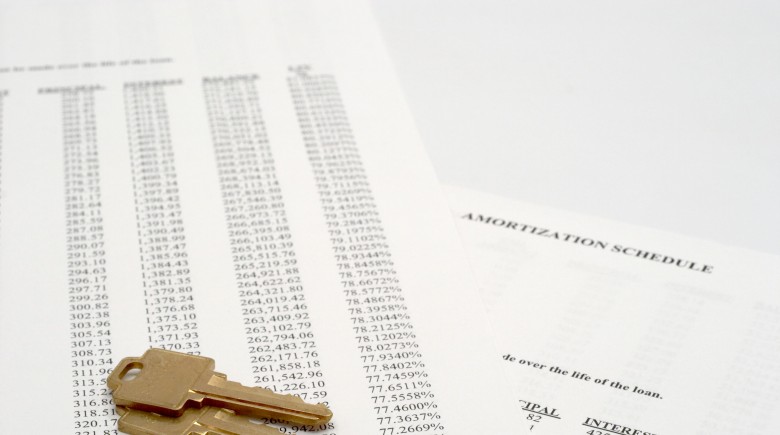Do you know your mortgage pay off date? Do you know how much interest you’ll pay over the life of your loan? Most borrowers don’t, but keeping tabs on where your money goes is an important aspect of managing your home loan. Maybe giving a read on your amortization tables is in order.
Amortization is the reduction of your loan principal over the life of your mortgage term, and when applying for a fixed-rate home loan, it’s customary for lenders to give an amortization table. Like most people, you’re simply happy to buy a house, and with regards to the break down of each payment, you could probably care less. As long as your principal goes down and you pay off the house in the 360th month, you may have no complaints.
But don’t file away your amortization table so fast. Taking a look at your table can help you assess the true cost of the mortgage loan. As you know, repayment of a mortgage isn’t only about the sale price of the house or the principal. Lenders charge interest, and in the beginning, a greater percentage of your payments go toward reducing the interest. Borrowers don’t typically like to think about the interest charges, and this is a reason why some don’t review their amortization table.
Take out a $200,000 fixed-rate mortgage for 30 years at 4.0% and you’ll pay about $143,730 just in interest alone – a grand total of $343,730. This is the ugly truth about mortgages that some people can’t stomach. They simply don’t want to come face-to-face with the total interest charges. But there’s another reason why some don’t read their table.
Because amortization tables are long and feature several columns, many assume that they’re complicated to understand. However, this couldn’t be further for the truth. These tables are organized and include all the information you need to keep track of your mortgage loan.
- Payment column: The first column of your amortization table lists each loan payment number. The numbers are 1 to 360 for a 30-year mortgage, and 1 to 180 for a 15-year mortgage. Next to each loan payment number is your actual loan payment amount, which doesn’t change throughout the table.
- Payment due column: The second column has the date that each payment is due. Payments are due the same day each month. Look at the last entry of the amortization table to learn your pay off date.
- Principal and interest columns: The next two columns on the amortization table break down your principal and interest charges. From this table, you’ll know exactly how the lender will apply each monthly payment. In the beginning, your lender applies the majority of your payment to the interest. However, things balance out the longer you have the mortgage. For example, with each payment in the initial years, your lender may only apply $300 to your principal and $600 to your interest. But as you near the end of the loan term, the opposite takes place and lenders apply a greater percentage to the principal.
- Balance column: After making a payment, this column will list your new loan balance, including principal and interest. The balance decreases each month until you reach a $0 balance in month 180 or 360, depending on the length of your mortgage term.
Do you know your mortgage pay off date? Do you know how much interest you’ll pay over the life of your loan? Most borrowers don’t, but keeping tabs on where your money goes is an important aspect of managing your home loan. Maybe giving a read on your amortization tables is in order.
Amortization is the reduction of your loan principal over the life of your mortgage term, and when applying for a fixed-rate home loan, it’s customary for lenders to give an amortization table. Like most people, you’re simply happy to buy a house, and with regards to the break down of each payment, you could probably care less. As long as your principal goes down and you pay off the house in the 360th month, you may have no complaints.
But don’t file away your amortization table so fast. Taking a look at your table can help you assess the true cost of the mortgage loan. As you know, repayment of a mortgage isn’t only about the sale price of the house or the principal. Lenders charge interest, and in the beginning, a greater percentage of your payments go toward reducing the interest. Borrowers don’t typically like to think about the interest charges, and this is a reason why some don’t review their amortization table.
Take out a $200,000 fixed-rate mortgage for 30 years at 4.0% and you’ll pay about $143,730 just in interest alone – a grand total of $343,730. This is the ugly truth about mortgages that some people can’t stomach. They simply don’t want to come face-to-face with the total interest charges. But there’s another reason why some don’t read their table.
Because amortization tables are long and feature several columns, many assume that they’re complicated to understand. However, this couldn’t be further for the truth. These tables are organized and include all the information you need to keep track of your mortgage loan.
- Payment column: The first column of your amortization table lists each loan payment number. The numbers are 1 to 360 for a 30-year mortgage, and 1 to 180 for a 15-year mortgage. Next to each loan payment number is your actual loan payment amount, which doesn’t change throughout the table.
- Payment due column: The second column has the date that each payment is due. Payments are due the same day each month. Look at the last entry of the amortization table to learn your pay off date.
- Principal and interest columns: The next two columns on the amortization table break down your principal and interest charges. From this table, you’ll know exactly how the lender will apply each monthly payment. In the beginning, your lender applies the majority of your payment to the interest. However, things balance out the longer you have the mortgage. For example, with each payment in the initial years, your lender may only apply $300 to your principal and $600 to your interest. But as you near the end of the loan term, the opposite takes place and lenders apply a greater percentage to the principal.
- Balance column: After making a payment, this column will list your new loan balance, including principal and interest. The balance decreases each month until you reach a $0 balance in month 180 or 360, depending on the length of your mortgage term.







